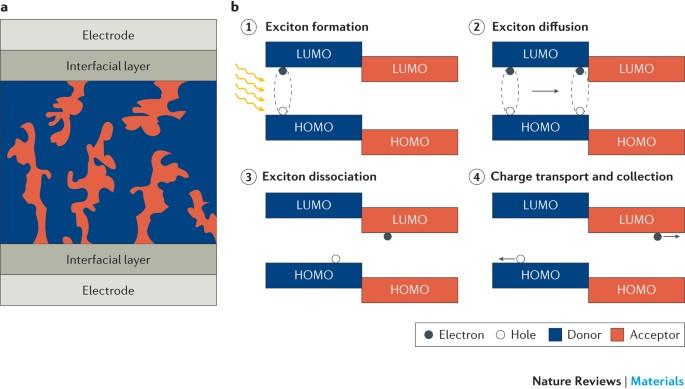Non-fullerene acceptors for organic solar cells
IF 79.8
1区 材料科学
Q1 MATERIALS SCIENCE, MULTIDISCIPLINARY
引用次数: 1732
Abstract
Non-fullerene acceptors (NFAs) are currently a major focus of research in the development of bulk-heterojunction organic solar cells (OSCs). In contrast to the widely used fullerene acceptors (FAs), the optical properties and electronic energy levels of NFAs can be readily tuned. NFA-based OSCs can also achieve greater thermal stability and photochemical stability, as well as longer device lifetimes, than their FA-based counterparts. Historically, the performance of NFA OSCs has lagged behind that of fullerene devices. However, recent developments have led to a rapid increase in power conversion efficiencies for NFA OSCs, with values now exceeding 13%, demonstrating the viability of using NFAs to replace FAs in next-generation high-performance OSCs. This Review discusses the important work that has led to this remarkable progress, focusing on the two most promising NFA classes to date: rylene diimide-based materials and materials based on fused aromatic cores with strong electron-accepting end groups. The key structure–property relationships, donor–acceptor matching criteria and aspects of device physics are discussed. Finally, we consider the remaining challenges and promising future directions for the NFA OSCs field. Non-fullerene acceptors have been widely used in organic solar cells over the past 3 years. This Review focuses on the two most promising classes of non-fullerene acceptors — rylene diimide-based materials and fused-ring electron acceptors — and discusses structure–property relationships, donor– acceptor matching criteria and device physics, as well as future research directions for the field.

有机太阳能电池用非富勒烯受体
非富勒烯受体(NFAs)是目前开发大块异质结有机太阳能电池(OSCs)的研究重点。与广泛使用的富勒烯受体(FA)相比,非富勒烯受体的光学特性和电子能级可以随时调整。基于 NFA 的 OSC 与基于 FA 的 OSC 相比,还具有更高的热稳定性和光化学稳定性,以及更长的器件寿命。一直以来,NFA OSC 的性能都落后于富勒烯器件。然而,最近的发展使 NFA OSC 的功率转换效率迅速提高,目前已超过 13%,这表明在下一代高性能 OSC 中使用 NFA 替代 FA 是可行的。本综述讨论了促成这一显著进展的重要工作,重点是迄今为止最有前景的两类非氟烷烃:基于亚甲基二亚胺的材料和基于具有强电子接受端基的融合芳香族核心的材料。我们讨论了关键的结构-性能关系、供体-受体匹配标准以及器件物理方面的问题。最后,我们探讨了非富勒烯受体 OSCs 领域仍然面临的挑战和未来的发展方向。在过去三年中,非富勒烯受体已广泛应用于有机太阳能电池。本综述重点介绍了两类最有前途的非富勒烯受体--基于亚甲基二亚胺的材料和熔环电子受体--并讨论了结构-性质关系、供体-受体匹配标准和器件物理以及该领域未来的研究方向。
本文章由计算机程序翻译,如有差异,请以英文原文为准。
求助全文
约1分钟内获得全文
求助全文
来源期刊

Nature Reviews Materials
Materials Science-Biomaterials
CiteScore
119.40
自引率
0.40%
发文量
107
期刊介绍:
Nature Reviews Materials is an online-only journal that is published weekly. It covers a wide range of scientific disciplines within materials science. The journal includes Reviews, Perspectives, and Comments.
Nature Reviews Materials focuses on various aspects of materials science, including the making, measuring, modelling, and manufacturing of materials. It examines the entire process of materials science, from laboratory discovery to the development of functional devices.
 求助内容:
求助内容: 应助结果提醒方式:
应助结果提醒方式:


